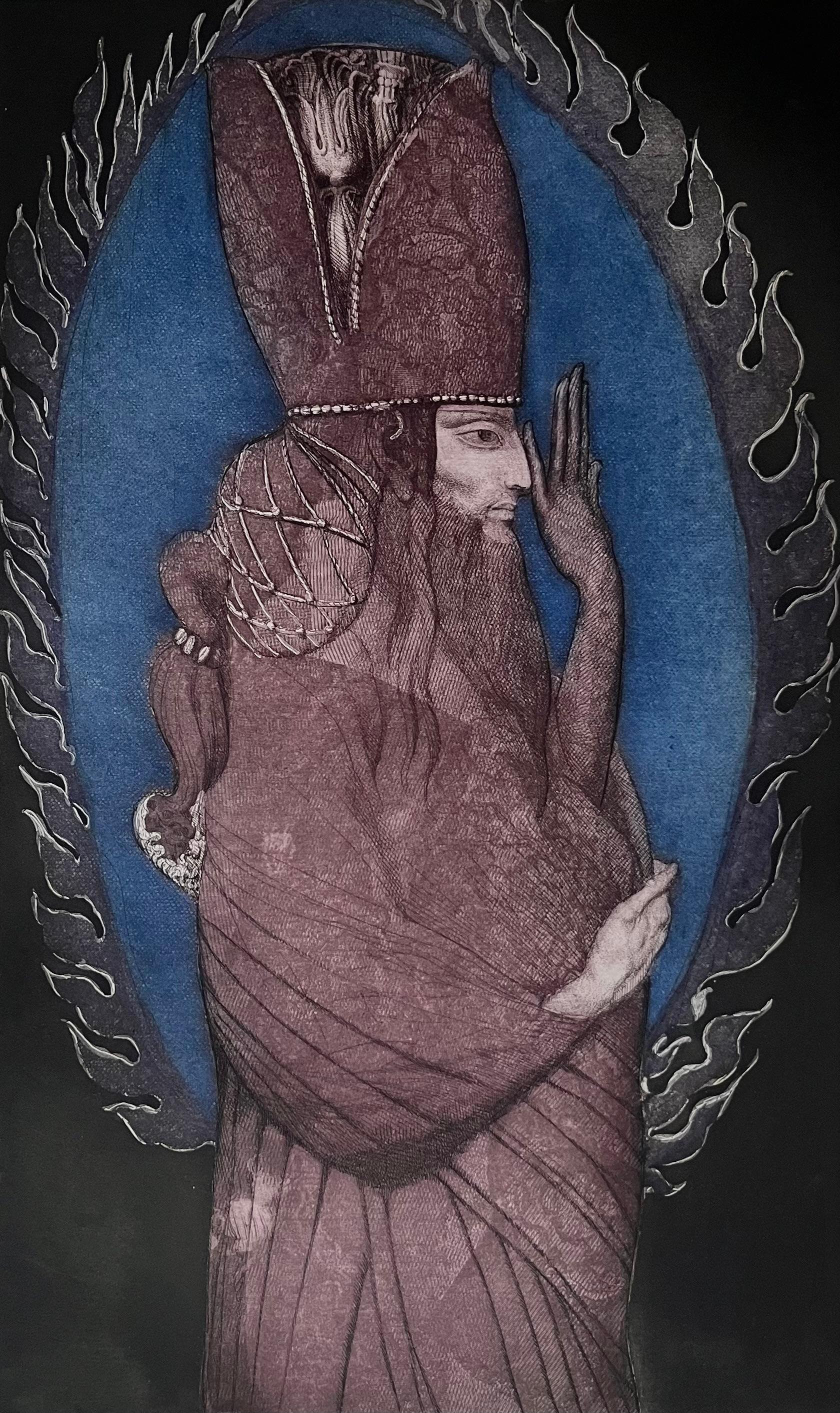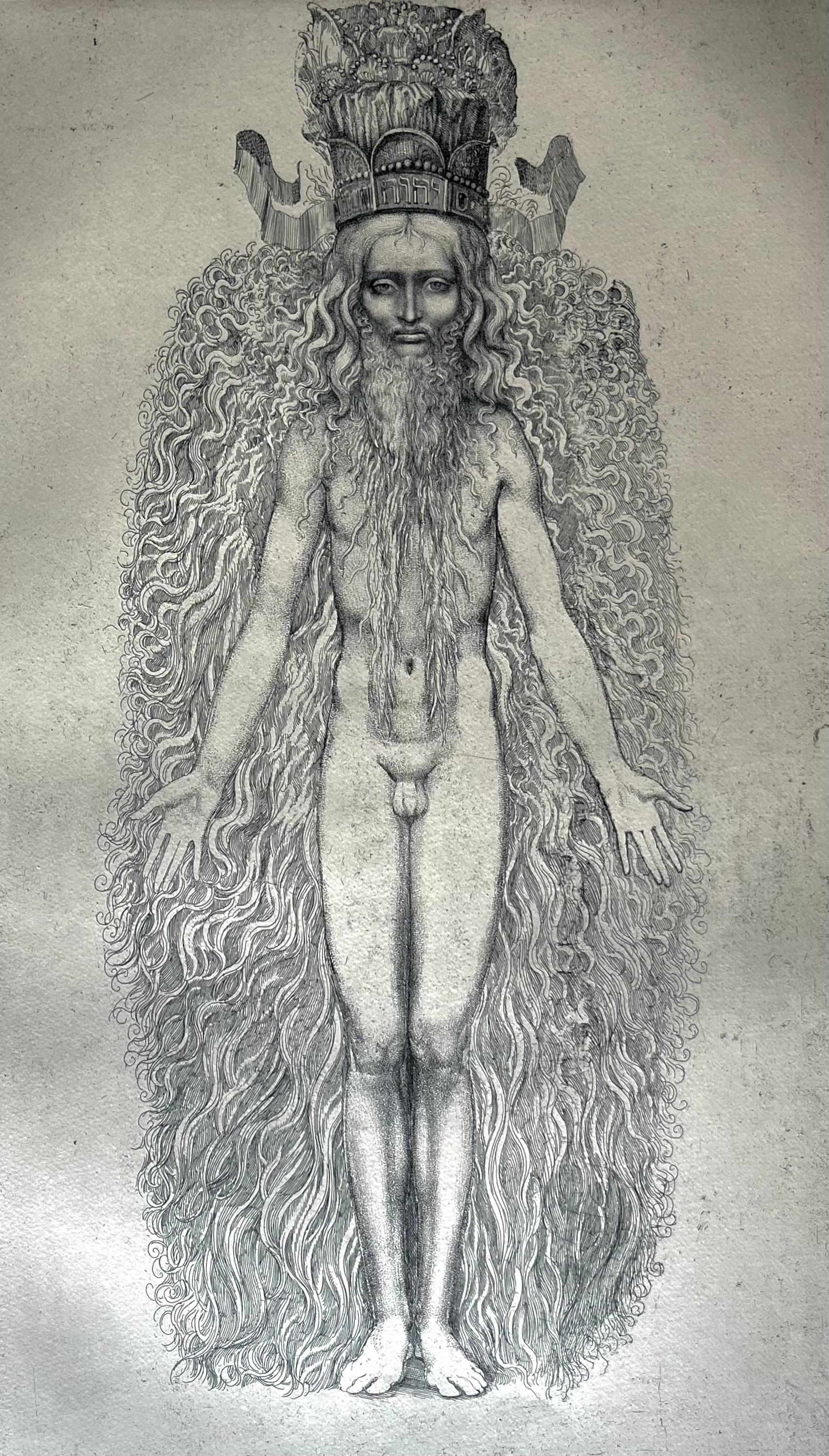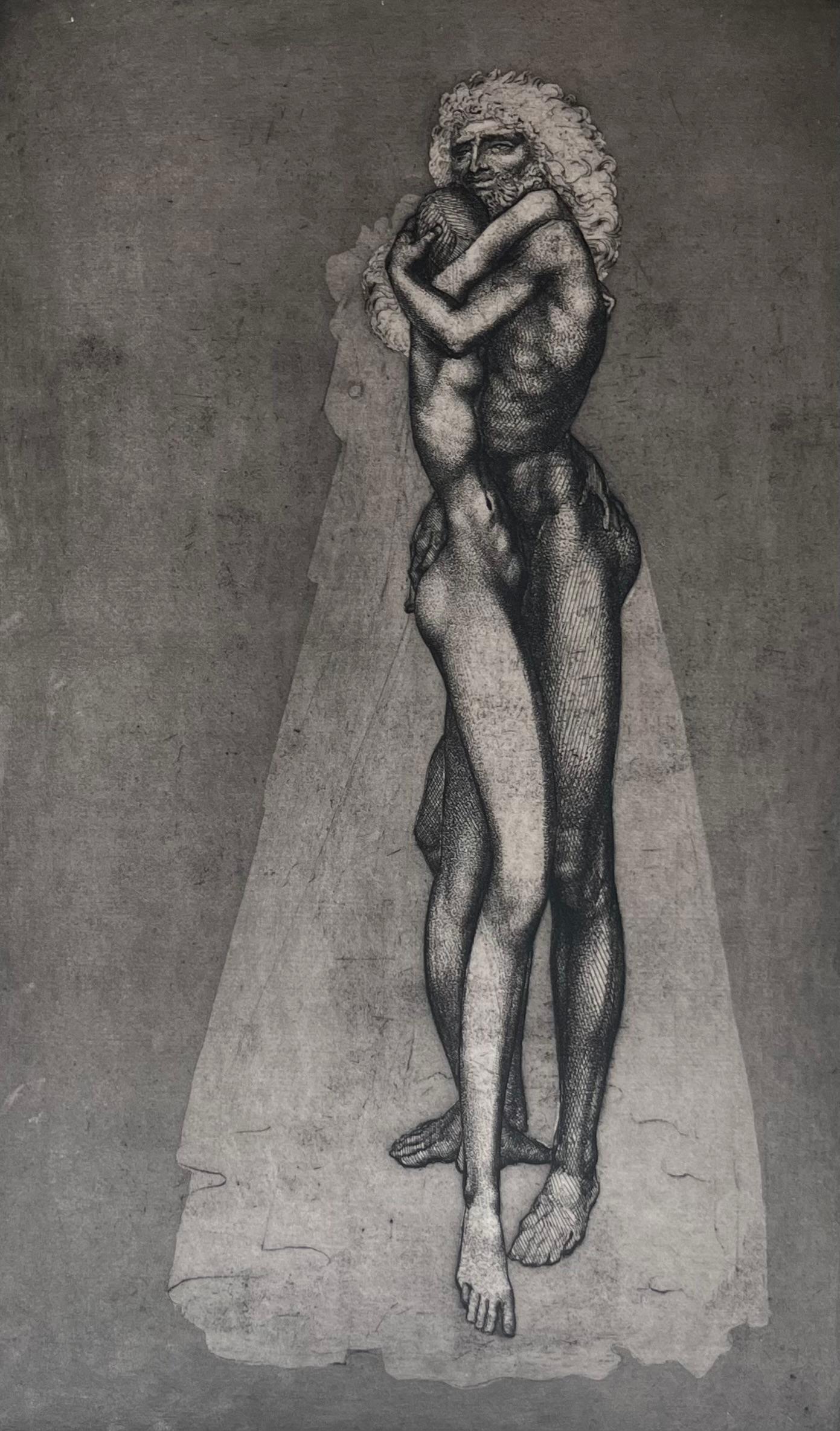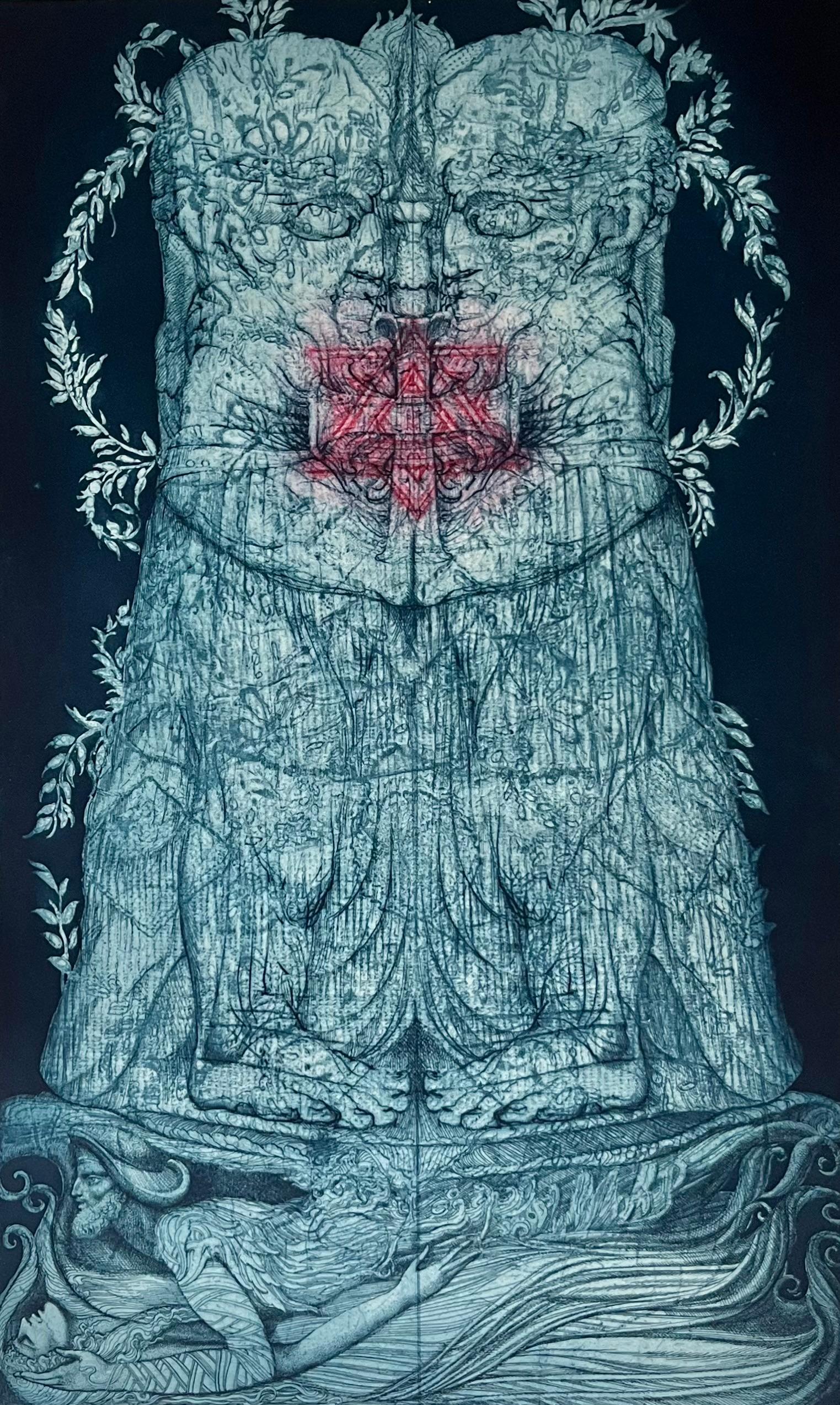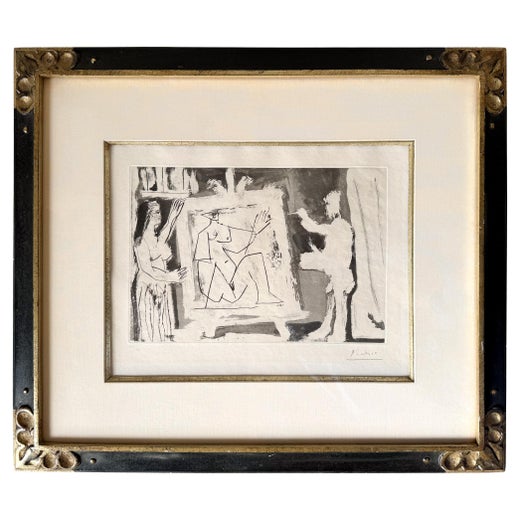Pablo Picasso"La Danse Barbare (from Les Saltimbanques), " Pablo Picasso, Figurative Print1905
1905
About the Item
- Creator:Pablo Picasso (1881-1973, Spanish)
- Creation Year:1905
- Dimensions:Height: 17 in (43.18 cm)Width: 21.75 in (55.25 cm)
- Medium:
- Movement & Style:
- Period:
- Condition:
- Gallery Location:New York, NY
- Reference Number:1stDibs: LU184129923952
Pablo Picasso
One of the most prolific and revolutionary artists the world has ever seen, Pablo Picasso had a tremendous impact on the development of 20th-century modern art. Although he is best known for his association with the Cubist movement, which he founded with Georges Braque, Picasso’s influence extends to Surrealism, neoclassicism and Expressionism.
“Every act of creation is, first of all, an act of destruction,” the Spanish artist proclaimed. In Picasso's Cubist paintings, he emphasizes the two-dimensionality of the canvas, breaking with conventions regarding perspective, foreshortening and proportion. Picasso was inspired by Iberian and African tribal art. One of his most famous pre-Cubist works is Les Demoiselles d’Avignon (1907), a painting considered immoral and shocking at the time for its depiction of nude women whose faces resemble Iberian tribal masks.
Picasso made many portraits in this style, most often of the women in his life, their expressively colored faces composed of geometric shards of surface planes. In Woman in a Hat (Olga), 1935, he painted his first wife as an assemblage of abstract forms, leaving the viewer to decipher the subject through the contrasting colors and shapes. Picasso was a tireless artist, creating more than 20,000 paintings, drawings, prints, ceramics and sculptures. Tracing his life’s work reveals the progression of modern art, on which he had an unparalleled influence.
Browse an expansive collection of Pablo Picasso's art on 1stDibs.
- ShippingRetrieving quote...Ships From: Larchmont, NY
- Return PolicyA return for this item may be initiated within 3 days of delivery.
- "The Capture, " Jacob Lawrence, Harlem Renaissance, Black Art, Haitian SeriesBy Jacob LawrenceLocated in New York, NYJacob Lawrence (1917 - 2000) The Capture of Marmelade (from The Life of Toussaint L'Ouverture series), 1987 Color screenprint on Bainbridge Two Ply Rag paper Sheet 32 1/8 x 22 1/16 inches Sight 29 3/4 x 19 1/4 inches A/P 1/30, aside from the edition of 120 Signed, titled, dated, inscribed "A/P" and numbered 1/30 in pencil, lower margin. Literature: Nesbett L87-2. A social realist, Lawrence documented the African American experience in several series devoted to Toussaint L’Ouverture, Frederick Douglass, Harriet Tubman, life in Harlem, and the civil rights movement of the 1960s. He was one of the first nationally recognized African American artists. “If at times my productions do not express the conventionally beautiful, there is always an effort to express the universal beauty of man’s continuous struggle to lift his social position and to add dimension to his spiritual being.” — Jacob Lawrence quoted in Ellen Harkins Wheat, Jacob Lawrence: The Frederick Douglass and Harriet Tubman Series of 1938 – 40. The most widely acclaimed African American artist of this century, and one of only several whose works are included in standard survey books on American art, Jacob Lawrence has enjoyed a successful career for more than fifty years. Lawrence’s paintings portray the lives and struggles of African Americans, and have found wide audiences due to their abstract, colorful style and universality of subject matter. By the time he was thirty years old, Lawrence had been labeled as the “foremost Negro artist,” and since that time his career has been a series of extraordinary accomplishments. Moreover, Lawrence is one of the few painters of his generation who grew up in a black community, was taught primarily by black artists, and was influenced by black people. Lawrence was born on September 7, 1917,* in Atlantic City, New Jersey. He was the eldest child of Jacob and Rosa Lee Lawrence. The senior Lawrence worked as a railroad cook and in 1919 moved his family to Easton, Pennsylvania, where he sought work as a coal miner. Lawrence’s parents separated when he was seven, and in 1924 his mother moved her children first to Philadelphia and then to Harlem when Jacob was twelve years old. He enrolled in Public School 89 located at 135th Street and Lenox Avenue, and at the Utopia Children’s Center, a settlement house that provided an after school program in arts and crafts for Harlem children. The center was operated at that time by painter Charles Alston who immediately recognized young Lawrence’s talents. Shortly after he began attending classes at Utopia Children’s Center, Lawrence developed an interest in drawing simple geometric patterns and making diorama type paintings from corrugated cardboard boxes. Following his graduation from P.S. 89, Lawrence enrolled in Commerce High School on West 65th Street and painted intermittently on his own. As the Depression became more acute, Lawrence’s mother lost her job and the family had to go on welfare. Lawrence dropped out of high school before his junior year to find odd jobs to help support his family. He enrolled in the Civilian Conservation Corps, a New Deal jobs program, and was sent to upstate New York. There he planted trees, drained swamps, and built dams. When Lawrence returned to Harlem he became associated with the Harlem Community Art Center directed by sculptor Augusta Savage, and began painting his earliest Harlem scenes. Lawrence enjoyed playing pool at the Harlem Y.M.C.A., where he met “Professor” Seifert, a black, self styled lecturer and historian who had collected a large library of African and African American literature. Seifert encouraged Lawrence to visit the Schomburg Library in Harlem to read everything he could about African and African American culture. He also invited Lawrence to use his personal library, and to visit the Museum of Modern Art’s exhibition of African art in 1935. As the Depression continued, circumstances remained financially difficult for Lawrence and his family. Through the persistence of Augusta Savage, Lawrence was assigned to an easel project with the W.P.A., and still under the influence of Seifert, Lawrence became interested in the life of Toussaint L’Ouverture, the black revolutionary and founder of the Republic of Haiti. Lawrence felt that a single painting would not depict L’Ouverture’s numerous achievements, and decided to produce a series of paintings on the general’s life. Lawrence is known primarily for his series of panels on the lives of important African Americans in history and scenes of African American life. His series of paintings include: The Life of Toussaint L’Ouverture, 1937, (forty one panels), The Life of Frederick Douglass, 1938, (forty panels), The Life of Harriet Tubman, 1939, (thirty one panels), The Migration of the Negro,1940 – 41, (sixty panels), The Life of John Brown, 1941, (twenty two panels), Harlem, 1942, (thirty panels), War, 1946 47, (fourteen panels), The South, 1947, (ten panels), Hospital, 1949 – 50, (eleven panels), Struggle: History of the American People, 1953 – 55, (thirty panels completed, sixty projected). Lawrence’s best known series is The Migration of the Negro, executed in 1940 and 1941. The panels portray the migration of over a million African Americans from the South to industrial cities in the North between 1910 and 1940. These panels, as well as others by Lawrence, are linked together by descriptive phrases, color, and design. In November 1941 Lawrence’s Migration series was exhibited at the prestigious Downtown Gallery in New York. This show received wide acclaim, and at the age of twenty four Lawrence became the first African American artist to be represented by a downtown “mainstream” gallery. During the same month Fortune magazine published a lengthy article about Lawrence, and illustrated twenty six of the series’ sixty panels. In 1943 the Downtown Gallery exhibited Lawrence’s Harlem series, which was lauded by some critics as being even more successful than the Migration panels. In 1937 Lawrence obtained a scholarship to the American Artists School in New York. At about the same time, he was also the recipient of a Rosenwald Grant for three consecutive years. In 1943 Lawrence joined the U.S. Coast Guard and was assigned to troop ships that sailed to Italy and India. After his discharge in 1945, Lawrence returned to painting the history of African American people. In the summer of 1947 Lawrence taught at the innovative Black Mountain College in North Carolina at the invitation of painter Josef Albers. During the late 1940s Lawrence was the most celebrated African American painter in America. Young, gifted, and personable, Lawrence presented the image of the black artist who had truly “arrived”. Lawrence was, however, somewhat overwhelmed by his own success, and deeply concerned that some of his equally talented black artist friends had not achieved a similar success. As a consequence, Lawrence became deeply depressed, and in July 1949 voluntarily entered Hillside Hospital in Queens, New York, to receive treatment. He completed the Hospital series while at Hillside. Following his discharge from the hospital in 1950, Lawrence resumed painting with renewed enthusiasm. In 1960 he was honored with a retrospective exhibition and monograph prepared by The American Federation of Arts. He also traveled to Africa twice during the 1960s and lived primarily in Nigeria. Lawrence taught for a number of years at the Art Students League in New York, and over the years has also served on the faculties of Brandeis University, the New School for Social Research, California State College at Hayward, the Pratt Institute, and the University of Washington, Seattle, where he is currently Professor Emeritus of Art. In 1974 the Whitney Museum of American Art in New York held a major retrospective of Lawrence’s work that toured nationally, and in December 1983 Lawrence was elected to the American Academy of Arts and Letters. The most recent retrospective of Lawrence’s paintings was organized by the Metropolitan Museum of Art in 2020, and was accompanied by a major catalogue. Lawrence met his wife Gwendolyn Knight...Category
1970s American Modern Figurative Prints
MaterialsScreen, Paper
- "Business-Men's Class, Y.M.C.A." George Bellows, Ashcan School PrintBy George Wesley BellowsLocated in New York, NYGeorge Bellows Business-Men's Class, Y.M.C.A, 1916 Signed, numbered "No. 41" and titled lower margin Lithograph on wove paper 11 1/2 x 17 1/8 inches Edition of 64 Provenance: Hirschl & Adler Galleries, New York Private Collection, Ohio Literature: Mason, 20. After his arrival from Columbus, Ohio in 1904, Bellows lived at the West Side YMCA. It was there that he met Eugene Speicher, another aspiring young artist who was to become his lifelong friend. Always interested in the anatomy of the human body, Bellows often satirized the various types who, while leading a sedentary life, feel compelled to devote a portion of their daily routine to physical self-improvement. Throughout his brief but illustrious career, George Wesley Bellows created striking scenes that documented ordinary American life in all its beauty and banality. Considered an American Realist, the artist eschewed embellishment, finding inspiration in the gritty boroughs of New York City, the rocky coastline of Maine, and, later, in his friends and family. Bellows garnered early recognition for his arresting portrayals of illegal prizefighting, dramatic works executed in dark tonal palettes that underscore the brutality of the violent sport. Bellows’ elderly Methodist parents hoped their son might pursue the ministry, a calling the extroverted athlete never received. The Columbus native competed on the baseball team at Ohio State University and also served as an illustrator for the college yearbook. In the fall of 1904—just months shy of his expected graduation—Bellows defied his father’s wishes and boarded a train to New York City in hopes of becoming a magazine illustrator like his idols Howard Chandler Christy and Charles Dana Gibson. Before leaving, he reportedly turned down an offer to play professional baseball with the Cincinnati Reds...Category
1910s Ashcan School Figurative Prints
MaterialsLithograph, Paper
- "Thanksgiving" Doris Lee, Family Genre Scene Interior, Americana, WPA, WoodstockBy Doris LeeLocated in New York, NYDoris Lee Thanksgiving, 1942 Signed lower right, titled lower left Lithograph on paper Image 8 3/4 x 11 3/4 inches Sheet 12 x 17 inches From the edition of 250 An American Scene pai...Category
1940s American Realist Interior Prints
MaterialsPaper, Lithograph
- "New York - Taken from the Northwest angle of Fort Columbus, Governor's Island"Located in New York, NYNew York - Taken from the north west angle of Fort Columbus Governor's Island, 1846 Engraved by Henry Papprill after a sketch by F. Catherwood, published by Henry J. Megarey Hand-colored engraving on paper Image 16 x 26 1/2 inches Henry A. Papprill (1816–1903) was a British engraver. Noted as an aquatint engraver from 1840. His plates were published from 1840 till 1883 mainly by Ackermann of the Strand. Papprill was born in Holborn, London. Lived for much of his life at Wharton Street, Lloyd Square, London. Papprill is thought to have been based in New York City for brief period in the mid-1840s. His work in the USA appears to classify him as an American engraver but he was based and gained his reputation and bulk of his work in England. He produced a series of works for Ackermann & Co from 1840 beginning with four plates called "The Jolly Squire", with verses, after James Pollard. In the following years Papprill engraved a number of military plates for Ackermann as well a series of engravings of New York (1846-9) for H.I.Megarey (published in New York). The most notable of these are: "The North West Angle of Fort Columbus, Governor's Island" (the Catherwood-Papprill view) and New York from the Steeple of St. Paul's Church, Looking East, South & West." (The Hill-Papprill view) listed in the American Historical Prints - Early Views of American Cities, etc: I.N.Phelps Stokes & Daniel C. Haskell. New York Public Library 1932. Papprill also produced for Ackermann a series of sporting prints after G. H. Laporte between 1860 and 1865. These were entitled: Racing, Hunting and Coursing. He also produced a series of shipping prints...Category
1840s Landscape Prints
MaterialsAquatint, Engraving, Paper
- "Untitled, " Joan Nelson, Modernist Trees and Clouds, Female ArtistBy Joan NelsonLocated in New York, NYJoan Nelson (American, b. 1958) Untitled, 1990 Color lithograph 16 x 16 inches From the edition of 45 Provenance: Mary Ryan Gallery, New York, 1991 Reader's...Category
1990s Modern Landscape Prints
MaterialsPaper, Lithograph
- "Offering, " Morris Graves, American Modernism, Owl, Bird, Gift, PresentBy Morris GravesLocated in New York, NYMorris Graves Offering, 1957 Signed and dated lower right Sumi ink wash and gold leaf on paper 18 x 13 3/8 inches Born in Fox Valley, Oregon in 1910, Morris Graves was a leading proponent of the Northwest School...Category
1950s Modern Animal Drawings and Watercolors
MaterialsGold Leaf
- Engraving #4 by Ernst Fuchs: KABBALAH (SEFER YETSIRA and 32 PATHS OF WISDOM)By Ernst FuchsLocated in Cliffside Park, NJOriginal engraving #4 by Ernst FUCHS from Kabbalah (THIRTY-TWO PATHS OF WISDOM by SEFER YETZIRA), 1978 Etching signed and numbered 16/30 E.A. Page size - 30 x 22 in 76 x 56 cm Image...Category
1970s Modern Figurative Prints
MaterialsPaper, Etching
- Engraving #5 by Ernst Fuchs: KABBALAH (SEFER YETSIRA and 32 PATHS OF WISDOM)By Ernst FuchsLocated in Cliffside Park, NJOriginal engraving #5 by Ernst FUCHS from Kabbalah (THIRTY-TWO PATHS OF WISDOM by SEFER YETZIRA), 1978 Etching signed and numbered 16/30 E.A. Page size - 30 x 22 in 76 x 56 cm Image...Category
1970s Modern Figurative Prints
MaterialsPaper, Etching
- Engraving #7 by Ernst Fuchs: KABBALAH (SEFER YETSIRA and 32 PATHS OF WISDOM)By Ernst FuchsLocated in Cliffside Park, NJOriginal engraving #7 by Ernst FUCHS from Kabbalah (THIRTY-TWO PATHS OF WISDOM by SEFER YETZIRA), 1978 Etching signed and numbered 16/30 E.A. Page size - 30 x 22 in 76 x 56 cm Image...Category
1970s Modern Figurative Prints
MaterialsPaper, Etching
- Engraving #13 by Ernst Fuchs: KABBALAH (SEFER YETSIRA and 32 PATHS OF WISDOM)By Ernst FuchsLocated in Cliffside Park, NJOriginal engraving #13 by Ernst FUCHS from Kabbalah (THIRTY-TWO PATHS OF WISDOM by SEFER YETZIRA), 1978 Etching signed and numbered 16/30 E.A. Page size - 30 x 22 in 76 x 56 cm Imag...Category
1970s Modern Figurative Prints
MaterialsPaper, Etching
- Engraving #3 by Ernst Fuchs: KABBALAH (SEFER YETSIRA and 32 PATHS OF WISDOM)By Ernst FuchsLocated in Cliffside Park, NJOriginal engraving #3 by Ernst FUCHS from Kabbalah (THIRTY-TWO PATHS OF WISDOM by SEFER YETZIRA), 1978 Etching signed and numbered 16/30 E.A. Page size - 30 x 22 in 76 x 56 cm Image...Category
1970s Modern Figurative Prints
MaterialsPaper, Etching
- Engraving #12 by Ernst Fuchs: KABBALAH (SEFER YETSIRA and 32 PATHS OF WISDOM)By Ernst FuchsLocated in Cliffside Park, NJOriginal engraving #12 by Ernst FUCHS from Kabbalah (THIRTY-TWO PATHS OF WISDOM by SEFER YETZIRA), 1978 Etching signed and numbered 16/30 E.A. Page size - 30 x 22 in 76 x 56 cm Imag...Category
1970s Modern Figurative Prints
MaterialsPaper, Etching
Recently Viewed
View AllRead More
Science Uncovers Hidden Truths behind Young Pablo Picasso’s Blue Period
From 1901 to 1904, Picasso limited his palette to bluish hues in producing some of his most famous early works. A new show looks at the recycled materials, hidden underpaintings, surprising influences and bohemian lifestyle that led to their creation.
Who Are the Most Popular Artists on 1stdibs?
Learn the stories of some of the world's most recognizable artworks and their makers.
